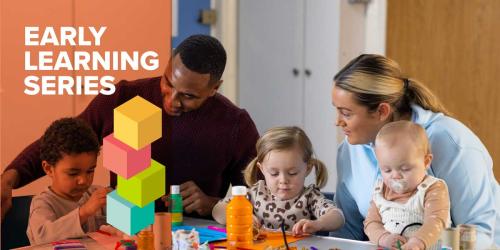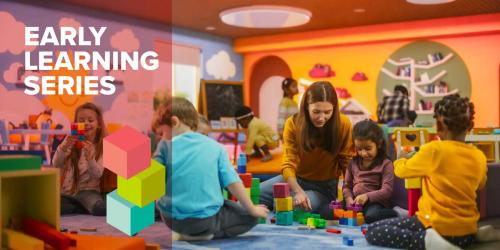How Wyoming Developed Early Learning Standards for Educators, by Educators

In 2016, Nikki Baldwin used her sabbatical from the University of Wyoming to travel to the far corners of the state. Her goal? To meet with early childhood educators and learn how they were using the state’s new early learning standards.
“My findings were: no one was using them,” said Nikki. “It was a strong standards tool—and almost everyone had a copy—but no one ever used it.”
That finding stuck with Nikki for years. When she got a chance to refresh the standards in 2020, Nikki saw an opportunity to do the standards differently: by elevating voices from the field.
Nikki spoke with Education Northwest—who helped evaluate the standards process—about how her team developed early learning standards that kept early childhood educators at the center.
Collaborate and Coordinate Funding
Nikki Baldwin has worked in Wyoming’s early childhood field for more than 20 years. Today, in addition to preparing future educators at the University of Wyoming, Nikki directs the Wyoming Early Childhood Outreach Network and the Wyoming Early Childhood Professional Learning Collaborative. Through all these roles, Nikki has learned the importance of working across regions, organizations, and systems to support educators.
In 2019, Nikki collaborated with several early childhood advocates in Wyoming to apply for—and win—a multimillion-dollar federal Preschool Development Grant. The grant provides funding for states to develop and carry out strategic plans to improve the quality of care, family engagement, workforce development, and systems collaboration, among other things.
One of the many activities funded through Wyoming’s Preschool Development Grant was refreshing the underutilized early learning standards. For the first time, the University of Wyoming was tapped to lead the project. Nikki assembled a team of early childhood educators and advocates—representatives who would gather insight from diverse providers across all regions of the state.
Design with the User in Mind
Nikki and her team dedicated themselves to developing standards that would be relevant to educators. They aimed to write standards that all providers—at preschool programs, child care centers, and family child care homes—could see themselves in.
“I knew that the only shot it had at being successful was if we deeply involved the workforce in its development instead of some top-down approach,” said Nikki. “I’m convinced that’s why other standards efforts have failed—they didn’t really involve the workforce.”
I’m convinced that’s why other standards efforts have failed—they didn’t really involve the workforce.
Following a process introduced by the organization Leading for Children, the Wyoming standards team elevated educators’ voices every step of the way.
“Our first ask of the standards team wasn’t to have their insight, but for them to get insight from everyone they had contact with in the field,” said Nikki. “We sent the team back to ask educators, ‘Are you using the current standards? And if not, why?’ Our first meetings were entirely about that.”
The focus on practice is evident in the final standards document: stories from the field, teacher tips, and equity connections are woven throughout. In addition, asset-based reflective questions invite Wyoming educators to consider how the work they already do aligns with the standards. Rather than being prescriptive, the standards document welcomes educators in as collaborators who bring valued expertise.
“Our number one hope is that people who read this document can see the value in elevating educator voices,” said Nikki. “The wisdom lies within the workforce to do this work, and the people who are experts in children are the people that work with them every day.”
Build on What Came Before
The Wyoming standards team did not start from scratch: They knew that many thoughtful people in Wyoming and elsewhere had spent years developing evidence-based guiding principles, standards, and frameworks.
“We didn’t invent the language,” Nikki explained. “We started with Wyoming’s previous set of standards, connected them to the Head Start Early Learning Outcomes Framework, then reviewed examples from comparator states, like Colorado, Montana, and Oregon.”
Through this process, the team realized that they could zero in on practical application while linking to existing research, guidance, and principles for anyone who wanted to dig deeper.
“Anyone can Google ‘developmentally appropriate practice,’” said Nikki. “People smarter than us had done all that work, so we could just link to it. We were not trying to be everything for everyone. We just tried to link to really good resources and show a lot of examples so teachers could see themselves in this document.”
Trust the Process … and the Educators
Nikki’s team knew they wanted to focus on educators, but seeing the scope of other states’ standards documents occasionally led them to feel overwhelmed.
“At one point we were ready to give up because we had seen everyone try to do standards in so many different ways. Any way we were going to try, someone had already done it better,” said Nikki. “A major point of clarity was when we realized that this was our best effort—the best effort of this group of people in this timeframe in this state—to put something out that teachers will use. We could let go of it having to be everything—the perfect standards tool that would last for 20 years. We realized that is the kind of tool we think we need, and this is the kind of tool we want to create.”
Just as the team needed to trust their educator-centered process, they also needed to trust educators and the expertise they would bring to the standards from the field. This is why the team organized Wyoming’s standards around measures of proficiency instead of indicators.
“I think indicators are built on a mistrust of teachers,” Nikki explained. “They assume only experts know where a child is supposed to be, so teachers just have to check a box. That’s not my experience in the classroom, and I don’t believe that values what teachers bring to the table. Standards fail at that point. Instead, measures of proficiency assume, ‘You know your children. You know what the standard is. How is the child showing you that they’re doing it?’”
The resulting tool offers flexibility to meet educators where they are—and where their children are.
Document, Evaluate, and Reflect
For Nikki, documenting and evaluating the standard development process was critical. She invited Education Northwest—external evaluators of Wyoming’s Preschool Development Grant—to document the process and, later, evaluate the use of standards in the field.
“I was impressed with Education Northwest’s work on the evaluation component of the Preschool Development Grant,” explained Nikki. “It’s noticeable when a team wants to understand deeply what’s happening, boots on the ground. I knew I could trust you as partners. I knew you understood our goals and would get at the things that we cared about and wanted to know.”
Education Northwest interviewed members of the standards team to document the process. Then, to understand how educators were using the standards in the field, Education Northwest conducted focus groups with educators across the state, administered educator surveys, and reviewed documents from educators showing how they applied the standards. For example, one teacher shared a custom assessment tool they developed based on the new standards.
“That was one of the happiest moments,” Nikki said. “If we just handed teachers a pre-made planning or assessment tool, they would recognize that it doesn’t fit their context in some way, small or large, and it would be set aside. I think how much more powerful that experience was, of using the standards to develop that tool for themselves, and how much more likely they are to use it.”
With the evaluation findings in hand, Education Northwest convened the Wyoming Preschool Development Grant leadership team to review the learnings and discuss takeaways—including how an educator-led process might benefit other early childhood work in the state.
“Thanks to Education Northwest, we know how the standards worked as a process and how they are working in the field,” said Nikki. “The Preschool Development Grant was a sprint—a four-year sprint. We needed time to slow down and reflect. And that’s what Education Northwest did for us: You gave us time to engage in dialogue around the work and how it’s working.”
Thanks to Education Northwest, we know how the standards worked as a process and how they are working in the field.
Promote, Educate, and Uplift
Now that the standards have been released, the hard work begins: putting the standards into practice.
Nikki continues to be involved with this important component of outreach and education. Just as with standards development, she and her team emphasize the importance of educator voice.
“Two weeks ago, we had a family home child care provider present about how she uses the standards. And we had an infant-toddler teacher from a child development center in Lander who has been using the standards for three years talk about how she uses the standards,” said Nikki. “We’re trying to elevate educators’ voices again and have teachers see that they can do it.”
Noting high turnover in the early childhood field, Nikki and her team have focused on introducing educators to the new standards and showing how they fit into the work educators are already doing. Nikki’s team of learning specialists, who each focus on a different region of Wyoming, travel to different communities and offer different learning formats so educators and providers can participate in ways that feel convenient and meaningful for them.
Whenever possible, they invite educators to lead with their expertise.
“We’re partnering with folks from the communities that are doing the work to have them share,” said Nikki. “That’s the most fulfilling piece of this: When other people step up and lead.”
Nikki ultimately hopes that Wyoming and other states will learn to trust in processes that in turn place trust in educators.
“If you engage in a process that doesn’t have a predetermined end, but you commit to learn together with educators, you engage with really big ideas, and you stay grounded in the evidence—whatever comes next is going to be useful and valuable to the field.”



